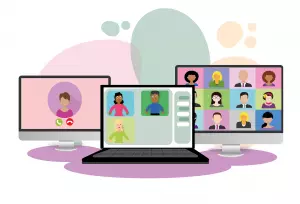It is now a fact that video is the present and the future of businesses. Currently, the average person spends over 100 minutes a day watching videos. In addition, over half of all data created daily is in the form of video.
Companies worldwide recognize the importance of video in various aspects of their operations. In light of this, over 70% of managers say that they use videos for marketing and sales.

However, video does not just play an important role for enterprises in marketing. Video is essential in internal communications and many other internal processes. As much as customers would like to see videos from their favorite brands, employees also prefer communication through video than through traditional means.
To achieve efficiency in communication and other employee-related processes, an enterprise requires a good employee video portal.
What is a video portal for employees?
A video portal refers to a video management system that provides access to various videos and an interactive interface that allows users to upload or stream videos. A video portal grants the user ability to upload, edit, organize and maintain their video catalog.
A video portal creates a flexible environment for users to organize their videos as they see fit. I
n addition, a video portal offers a single platform to accommodate videos for different purposes.
As the name implies, an employee video portal is created with the organization’s employees in mind. These video portals are restricted because only those within the organization have access to them.
Managers can also set further restrictions to limit access to only a set of employees.
Employee video portals use video to cater to various employee needs. It is a cost-effective means for training and educating employees. It also creates an environment for employees to have fun as they connect.
An employee video portal is beneficial to enterprises at all levels, helping them save time, money and effort.
Why do enterprises need a video portal on top of their Internal Communication platform?

Internal communication and employee engagement are two of the biggest challenges most enterprises face. Unfortunately, communication via traditional means like emails, memos, letters and even verbal directives is often inefficient in engaging the employees.
While physical meetings are effective in corporate communication, they require significant expense and effort to plan and are often time-wasting.
Internal communication videos conveniently solve all the inter-team and inter-person communication problems within organizations.
An employee video portal does not just enable internal communication but also makes many other enterprise activities seamless.
An employee video portal saves a company considerable cost in organizing physical sessions for anything, from onboarding to training.
In addition, it creates an avenue for employees to stay healthily connected and fosters innovation and rapid solutions to problems.
Here are some of the top reasons why enterprises need video portals.
Recruitment
Companies are constantly looking for top talent to help them achieve their goals and objectives. Recruitment videos have shown great efficiency in helping organizations recruit the best caliber of employees.
Through video, organizations can concisely communicate their work culture and show top talents why they would want to work for them. A creative video is more likely to capture the mind of innovative tech-savvy candidates who will add the best value to the organization.
A survey showed that companies received 34% more applications when using a recruitment video than advertising through traditional means.
Onboarding New Employees
Onboarding new employees entails integrating them with the company and its culture and introducing them to their roles and the tools and information required to be productive.
A company must be able to quickly and efficiently onboard their new hires to enable them to contribute to the company’s success, and video provides an engaging way to accomplish that.
Well-crafted onboarding videos can turn complex information into interesting, easy-to-understand formats. This allows your recruits to take in all of the information at their own pace.
In addition, onboarding videos save HR the precious time to repeatedly go over processes with recruits.
Training Employees
No matter how good they are at their job, employees need consistent training to refresh their knowledge, stay updated with new industry trends and gain new competencies.
Employee training is an essential part of any enterprise’s push for better results. However, the time, effort and cost needed to organize high-quality training modules consistently are often off-putting.
Besides, many organizations lack the necessary space to host training sessions (more cost). In addition, employees usually have different deadlines to meet, so finding a suitable time is usually difficult (more time and effort).
Employees also have different attention spans, and some employees may not benefit as much as others from physical training sessions.
This is where video comes in. By creating a creative training video, organizations can capture employees’ attention raptly and pass on the knowledge easily. Because employees can tune in at their convenience, the company can save the costs of flying in the trainers, lodging them and renting a location for the session.
In addition, by having an interactive video, organizations will know the employees’ opinions on the session, see how well the training has impacted them, and see what they can improve upon.
According to data from the SAVO Group, the average employee forgets about 65 percent of the material covered only seven days after a traditional training session, increasing to about 90 percent after six months.
Video is a visually exciting medium that helps people recall concepts, details, and information for extended periods. Using video training also ensures that workers have a consistent learning experience, ensuring that they all acquire vital information in the same way.
Corporate Communications
Corporate communication refers to how organizations pass information to internal and external audiences. It is also an essential tool for HR to communicate its goals and visions to all staff members regularly.
Video portals allow HR personnel to communicate information efficiently; employee appraisals, job descriptions, policies and procedures without much fuss.
In addition, video communication ensures that employee engagement is high and that HR can monitor how the communication video is interacted with.
Internal Product Launches
Videos are beneficial when launching products internally. They are an efficient and concise way to train all staff members on the usability and importance of the product.
Product launch through a video saves time and cost associated with organizing physical events. In addition, employees can call back on the video to pick up new information that they may have missed about the product.
Employee Engagement
Employee engagement is paramount in helping an organization achieve long-term growth. If employees believe the work they’re doing and are more engaged with their daily tasks, productivity is bound to increase.
Employee engagement is a massive challenge for many enterprises in today’s social media world. However, using video significantly solves this problem, boosting information retention rate 9x compared to traditional texts.
A video portal allows an enterprise to create videos that “speak directly” to each employee.
Live stream sessions can be held where employees can speak directly with the top management and communicate their feelings, and get better motivation and appraisal of their work.
A video portal with an analytics tool will also allow HR to study how employees interact with each video and what changes to make improvements.
Why is Corporate Communication Important?

Communication in the business world is as important as in the personal world. A corporate communication plan is an essential aspect of every company setting.
This impacts not just how top-level executives communicate with one another and their teams but also on how everyone in the firm communicates with their clients and consumers.
Team members frequently miss critical information, feel left out, or are continuously perplexed about why they are assigned specific tasks or responsibilities if there is ineffective business communication.
However, by fostering a culture of purposeful corporate communication, businesses may foster a growth-oriented atmosphere that will benefit their bottom line.
In its broadest sense, corporate communication is the process of establishing, nurturing, and sustaining a consistent brand image and identity.
Effective corporate communication aids in the development of a company image that fosters internal loyalty as well as external consumer loyalty.
Corporate communication combines public media relations, internal communication and managing relationships with investors, customers and the public.
When these things are in sync, the message sent to internal and external sources is consistent and trustworthy. However, when corporate communication fails, it can lead to suspicion or feelings of betrayal, and the company suffers. Corporate communications is also important for the following reasons;
1. Enables Transparency
Effective communication creates a transparent atmosphere within the workspace. Effective communication entails employees knowing and appreciating their role and importance within the firm.
Likewise, investors and consumers know what is truly going on within the company than just being kept in the dark. This transparency builds trust and makes all parties more invested in pushing the company forward
2. Minimizes miscommunication
Miscommunication is a bane of many modern workplaces.
For example, different teams or personnel often have different information regarding a project, such as the deadlines, which leads to internal conflict.
However, effective corporate communication ensures that all teams are on the same page, reducing the chances of error and conflict.
3. Improves Employee engagement and productivity
Effectively communicating the company’s goals to employees helps them connect their everyday tasks to achieving the bigger picture.
When communication achieves its inherent role, every employer becomes engaged with the company identity and will strive towards achieving the goals. In addition, engaged employees will stimulate other employees to work towards the greater good.
4. Helps build corporate identity
Corporate communication is the best strategy in building a long-term corporate identity.
A well-articulated corporate communication strategy, along with good PR campaigns, reinforces a positive image of an enterprise, both internally and externally.
5. Helps in recruiting top talent
Effective corporate communication successfully conveys a company’s objectives to all and sundry. As a result, top talent will be willing to work for the company since they know they can rely on the available information to carry out their tasks effectively.
In addition, an effective communications strategy is often an indication of a desirable work environment, thus inspiring young, hard-working candidates to aim towards that.
Effective corporate communication galvanizes employees and stakeholders towards a common objective. In addition, as tasks between departments are effectively communicated, efficiency will increase significantly.
Corporate communication, when effective, ensures that every member of the company is making a massive contribution towards company productivity.
Using video in corporate communication

The use of video has consistently been demonstrated as an efficient strategy for corporate communications.
Internal communication videos significantly improve internal corporate communication, help recruit top talent, empower employees and promote synergy between departments.
Videos marry words and visuals and stimulate employees’ brains’ creative and retentive centers. Compared to texts or mere audio, videos are more engaging and make it easier for employees to follow instructions.
Other importance of using video for corporate communication includes;
- Videos are easy to distribute, and employees can access them remotely
- Videos save cost and time associated with distributing information through other means
- Videos stimulate the visual centers through which most people learn. Thus, the information through video is more likely to stick than through other media
- Video ensures that miscommunication is eliminated. For example, you can create one video and distribute it to all teams, ensuring everyone is on the same page.
7 Benefits of Video Portal for Employees
Video portals are not just beneficial to the employer. They also hold numerous benefits for the employees themselves.
Some of the benefits that employees gain from video portals include;
- Facilitates easier communication with one another and with management teams
- Fosters camaraderie with one another
- Reduces stress associated with attending physical meetings and training sessions
- Creates a flexible work environment, allowing them to learn and pick information at their own pace
- Promotes a better work-life balance and improves the quality of life.
- Improves employee efficiency, allowing them to maximize output with little effort
- Allows each employee to learn from others, which hastens the learning process.
Create your own YouTube-like Video Portal for Employees: Enterprise VideoTube

Cincopa video tube gives enterprises a platform for easy corporate communications. Cincopa’s video management system is similar to YouTube but tailored for organizations.
Cincops’s internal communication solution allows enterprises to create white-label channels for internal communications.
As a result, organizations have complete control over uploading, storing, organizing, sharing and monitoring their videos. In addition, the security offered by the platform will allow them to communicate internally without leaking confidential information.
Hosting internal communication videos on Cincopa ensures that enterprises boost employee engagement.
Enterprises will also enjoy many benefits such as;
Leverage to easily organize video content.
Organizations may store their data in a secure environment that is exclusively theirs. Employees can easily find videos they need to complete a project since all videos are kept in a single secure location.
One advantage of the Cincopa video tube is that team leaders may build unique channels for certain projects and restrict access to those channels to just team members.
This allows teams to modify video assets all in one location, decreasing the risk of misunderstanding.
Detailed video analytics
Cincopa Video Tube provides team leaders analytics to see how employees engage with certain videos.
By evaluating these indicators, organizations may learn which areas need improvement and which personnel need extra attention in certain areas. As a consequence, everyone in the organization is on the same page.
Video Streaming on any device
The Cincopa video tube is optimized for both web and mobile view.
That way, your employees can access the videos with their computers or phones without any limitation to the quality of streaming or the quality of the video.
Secure Live Streaming and VOD options
Cincopa Video tube allows enterprises to create corporate communication videos of any type, including live stream videos and video-on-demand (VOD).
Organizations may choose to live stream training sessions, or after a large recruitment exercise, may choose to live stream their onboarding video so that every new employee may access it remotely in real-time.
On the other hand, training or onboarding videos may be pre-recorded and saved as VOD. That way, once employees log in to their video portal, they can easily access this video and catch up with the necessary information.
Internal communication videos may also be created in either form, allowing team members to come together in real-time or access information at their convenience.
Enhance your Video Portal for Corporate Communication

Hosting your employee video portal on a private video platform is half of the process of ensuring effective corporate communication.
You still have to ensure that you optimize your videos and channels so that employees can enjoy browsing through them.
Here are some tips to enhance your video portal for corporate communication
- Curate and organize videos in proper order so that employees can locate what they’re looking for.
- To make searching simpler, tag videos with keywords and add descriptions.
- Including transcripts and captions will aid in learning. Reading while listening aids retention, and when a transcript is provided, employees may easily locate the information they need.
- To guarantee that viewers don’t merely watch passively, provide interactive components like quizzes or polls.
- Employees should be able to rate and review content.
- Consider sending out a monthly email that includes links to recent videos.
Bottom Line
Cincopa’s video portal for employees greatly solves the problem of corporate communication within your organization. It also helps with other processes like onboarding, training and employee recruitment.
Create a video portal today to enjoy the many benefits for your businesses.









